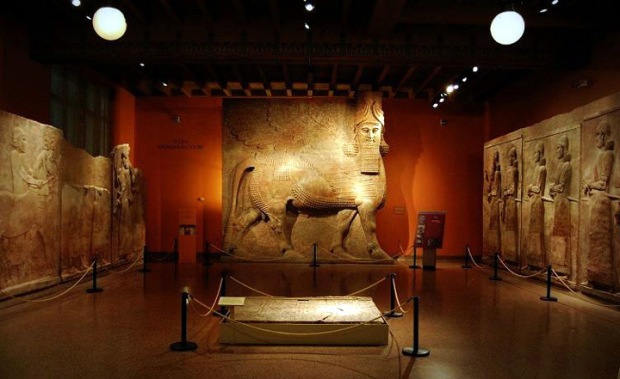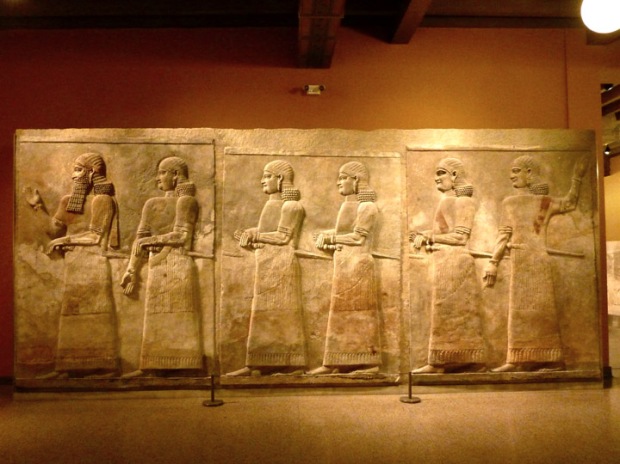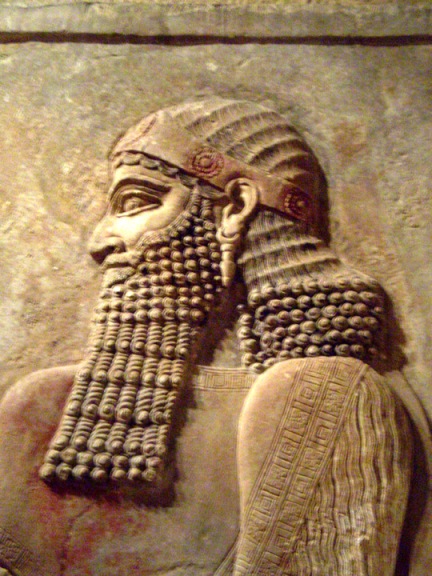Royal Revisions in Assyrian Art

We sometimes forget that beautiful works of art may have been created with ulterior motives. Think of a pharaoh using a heroic frieze to solidify his power, an elegant Renaissance chapel donated to erase the sins of the patron, or a lovely oil portrait sent to encourage a royal marriage. Sometimes the circumstances behind the message change and the image must be adjusted. I notice one such major revision in Chicago and was surprised to hear about some political turmoil that led to the defacement of a glorious royal sculpture.

The Khorsabad Gate, Oriental Institute, University of Chicago (Photo: American Lady, Flickr)
The University of Chicago’s Oriental Institute Museum has a great, concise collection of Mesopotamian, Egyptian, Anatolian and Persian art. The central feature of the first gallery is the The Khorsabad Gate (ca. 721-705 BCE). The central bull and procession reliefs would have adored the entrance to the throne room of Assyrian King Sargon II. I’ve already written about some “artistic license” taken in creating the massive human-headed, winged-bull but there is something else peculiar about this scene and it suggests some nasty politics.

Procession of figures from The Khorsabad Gate (Photo: John Kannenberg, Flickr)
The procession relief is led by a bearded man followed by 5 clean shaven men. Looking closely though, the second man once had a beard but it had been somewhat crudely chiseled off. I could see the outline of a square beard along this chest. Also the roses from his headband had been obliterated.
I asked the museum staff (who were very happy that I noticed the obliteration) what this meant. Apparently the king had had two close male relatives, perhaps brothers or sons, which had been shown wearing royal beards and leading a procession of priests. At some point there was a betrayal or a power grab and the second man was completely removed from all records (and presumably also from his position). The beard and headband were changed to turn the figure in this procession into another priest.
The transformation was not quite complete. Even if the alterations were not visible, the second man is posed in such as way to suggest a more esteemed figure and still has a rose bracelet. Major changes to the piece would have been too disruptive, but a contemporary viewer would have understood the point of removing the man’s beard. If image is everything, the point has been made very clearly in this altered procession!
(Side note: I also like that black and red paint is still visible on the lead figure and some of the priests. We forget that the ancient world was painted, so I like to see sculpture with traces of color!)







Awesome post and terrific photos.
LikeLike
Reblogged this on Art History Ramblings.
LikeLike
Fascinating post, Christina. It just goes to show the significance of facial hair stylings then and now. It must have taken hours to curl the Assyrian nobles’ beards. I was captivated recently by the sophistication of Assyrian sculpture and artifacts at a show in Toronto, called Mesopotamia: Inventing Our World. Very, very fine. Terrible that so much scholarship and art has been looted or destroyed because of the war in Iraq. For anyone interested, my photos of Assyrian sculpture at the ROM Toronto exhibition can be seen at http://tinyurl.com/q2uahjx
LikeLike
Thanks Lesley! Your photos are wonderful! The art of the Ancient Near East is something I saddly don’t know enough about. It’s great to see shows like that one in Toronto and the Oriental Institute presenting this period so well.
LikeLike